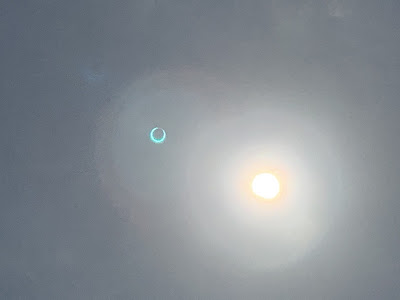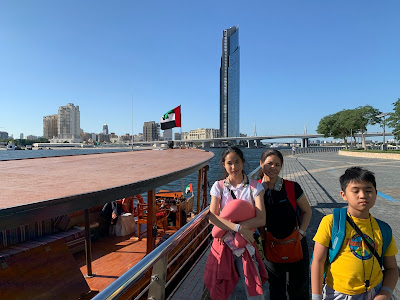2019 has passed by so quickly and let's hope 2020 will be a good year for everyone! Cheers!
Tuesday, December 31, 2019
31 Dec 2019 - New Year Eve Dinner
Today is the last day of 2019 and we all gathered for a new year's eve dinner.
29 Dec 2019 - The Singapore Ants Exhibition
Ants are all around us but do you know that they are one of the most advanced species on the planet that have survived for the past 120 Million years! Today we had an educational family tour to The Singapore Ants Exhibition to find out more about these amazing creatures.


Next we came to a colony of black crazy ant, which gets its name from its very fast erratic movement when disturbed. Unlike other ants, its hairs are white and they have very long legs and antennae. The queen ant of this species can actually clone herself, which is why it is also known as the Immortal Ant.
We continue our learning journey to the colony of Iridomyrmex bicknelli, which is a "peace loving" species that chooses to avoid confrontation whenever possible. Their nests can be found in various locations from barren footpaths, underneath soil, to sandy beaches. It is one of the few species that can nest in pure sand.
The next enclosure is a colony of Camponotus auriventris, also known as The Black Sugar Ant. As this is a day active species, it has an attractive metallic sheen on the gaster which protects them from ultraviolet (UV) rays.
We then proceeded to the next colony of Camponotus Irritans, which is a species of carpenter ant. This species got their name when they swarm and irritate their discoverer. It is also having a name of The Giant Honey Ant due to its colour. The colour gradient in its appearance construes its versatility to nest in both soil and logs.
The following species is called Camponotus albosparsus. It is the smallest camponotus species found in South East Asia. It is easy to identify its worker by two circle dots on its abdomen like two eyes on a face, using it to scare off predators. The albosparsus likes to nest under logs and holes in the ground. A rather timid species, they scavenge for food rather than hunt. One unique behaviour is that they raise their abdomens and do thrusting movements to scare their enemies when threatened.
The next species that we saw is called Tetraponera rufonigra, or The Arboreal Bicolor Ant. These species are arboreal and nest in tree trunks in the wild. They are highly aggressive and have very good eyesight. They also have a potent sting that can cause allergic reactions and/or fatality in humans if stung multiple times.
Below enclosure is a colony of Solenopsis geminata. The sting of this species feels like a cigarette burn, hence it is more commonly known as the Fire Ants. These ants are invasive and have caused disruptions on ecosystems across the world. They pose a big threat as they are highly aggressive, breed and propagate quickly, risking the native ants being wiped out. They have an effective sting that can cause pain and itch over an extended period of time if stung by them.
We moved on to the next enclosure where we saw a colony of Camponotus Parius, which are normally mistaken for its counterpart, Camponotus auriventris mentioned above. It is smaller compared to auriventris species and has a behaviour similar to it. The queen of the parius species differs from the auriventris queen in the colour of its abdomen which is a darker shade of grey without the green sheen.
Then we came into a close encounter with Odontoponera denticulata, or Toothed Ponera. These ants are solitary hunters of arthropods about its size. They are well structured with a strong pair of mandibles ("jaws"), using it to subdue its prey when hunting. They sometimes work together to bring down larger prey if needed. This species has a special way of rolling water into a ball to bring it back to the nest for hydration and feeding. They do not use the conventional method of trophallaxis (transferring of food from mouth to mouth) to feed its young, but carry bits of food near the larvae whereafter they feed themselves.
Below are some other ant species that we saw during the visit.
It's a great family day out before school starts in a few days time.

The place is rather small but you do not need a huge space to showcased ants. We were able to ave up close views on varying species of ants in their habitats in a safe and controlled environment. There was also guides who share and educate visitors on the lives of ants and even, the joys of Antkeeping as a hobby!

Now let me introduce some of the ants that we saw in the exhibition. First the guide introduced to us one of the largest species of ants in the world, Dinomyrmex gigas, also known as Giant forest ant. This large charismatic ant can be found in the forests of Singapore and Southeast Asia. However it is not often sighted by the public due to its predominant nocturnal activity. The size of their queen ants are as large as AA batteries!
We continue our learning journey to the colony of Iridomyrmex bicknelli, which is a "peace loving" species that chooses to avoid confrontation whenever possible. Their nests can be found in various locations from barren footpaths, underneath soil, to sandy beaches. It is one of the few species that can nest in pure sand.
The next enclosure is a colony of Camponotus auriventris, also known as The Black Sugar Ant. As this is a day active species, it has an attractive metallic sheen on the gaster which protects them from ultraviolet (UV) rays.
We then proceeded to the next colony of Camponotus Irritans, which is a species of carpenter ant. This species got their name when they swarm and irritate their discoverer. It is also having a name of The Giant Honey Ant due to its colour. The colour gradient in its appearance construes its versatility to nest in both soil and logs.
The following species is called Camponotus albosparsus. It is the smallest camponotus species found in South East Asia. It is easy to identify its worker by two circle dots on its abdomen like two eyes on a face, using it to scare off predators. The albosparsus likes to nest under logs and holes in the ground. A rather timid species, they scavenge for food rather than hunt. One unique behaviour is that they raise their abdomens and do thrusting movements to scare their enemies when threatened.
The next species that we saw is called Tetraponera rufonigra, or The Arboreal Bicolor Ant. These species are arboreal and nest in tree trunks in the wild. They are highly aggressive and have very good eyesight. They also have a potent sting that can cause allergic reactions and/or fatality in humans if stung multiple times.
Below enclosure is a colony of Solenopsis geminata. The sting of this species feels like a cigarette burn, hence it is more commonly known as the Fire Ants. These ants are invasive and have caused disruptions on ecosystems across the world. They pose a big threat as they are highly aggressive, breed and propagate quickly, risking the native ants being wiped out. They have an effective sting that can cause pain and itch over an extended period of time if stung by them.
We moved on to the next enclosure where we saw a colony of Camponotus Parius, which are normally mistaken for its counterpart, Camponotus auriventris mentioned above. It is smaller compared to auriventris species and has a behaviour similar to it. The queen of the parius species differs from the auriventris queen in the colour of its abdomen which is a darker shade of grey without the green sheen.
Then we came into a close encounter with Odontoponera denticulata, or Toothed Ponera. These ants are solitary hunters of arthropods about its size. They are well structured with a strong pair of mandibles ("jaws"), using it to subdue its prey when hunting. They sometimes work together to bring down larger prey if needed. This species has a special way of rolling water into a ball to bring it back to the nest for hydration and feeding. They do not use the conventional method of trophallaxis (transferring of food from mouth to mouth) to feed its young, but carry bits of food near the larvae whereafter they feed themselves.
Diacamma rugosum are queenless ants which are "ruled" by a sole gamergate. Eclosed ants are ergatoid queens which becomes ordinary workers after the amputation of their gemma by the gamergate. Gemmas are special glands which enable reproduction. Only the selected gamergate retains their gemma and carry out egg laying. Diacamma workers guide each other by tandem running to and fro from the food source. When a gamergate dies, the newly eclosed ants which have their gemma will fight for gamergate status, after which they amputate the gemma from all other ants.
The following species, Anoplolepis gracilipes, is one of the most feared invasive species which form supercolonies by merging. It is infamous for its destructive impact on Christmas Island, causing rapid depletion of migrating red crab population, due to killing and eating them and using their burrows as nesting sites. They are also responsible for increased densities of scale insects of which they farm for honeydew, leading to the deaths of large forest trees.Below are some other ant species that we saw during the visit.
At the entrance/exit, there was a whole range of ants enclosures and equipment for sale. Overall, this was a very unique experience to come up close to these little creatures and we all enjoyed it.
We had lunch at I12 Katong Mall which is just across the road. After lunch, we went for a movie called "Spies in Disguise", which is a high-flying animated comedy.It's a great family day out before school starts in a few days time.
26 Dec 2019 - Annular Solar Eclipse
The main discussion on the island today has to the annular solar eclipse that happened between 11:30am to about 3:20pm. It peaked at 1:24pm when people from all around the island witnessed this rare event during lunch time. If you missed it today, you will have to wait till 2063 to have another chance to watch it.
25 Dec 2019 - Christmas Lunch at Tim Ho Wan (添好运)
It's Christmas Day and we decided to go for our Xmas lunch at Tim Ho Wan (添好运) at Tai Seng. Merry Christmas to all!
23 Dec 2019 - Secondary One School Registration
It's secondary one school registration today. Early in the morning, we walked to Bowen Secondary School which is just a short 5 minutes walk from our place. We assembled at the hall where the registration took place. Initially Jerlene was a bit anxious but when she found out that one of her ex-classmates in Rosyth is in the same class as her, she felt relieved.
After registration, we walked around the school to get ourselves familiarized. The canteen caught my attention as the furniture looks new and it's all individual chairs, unlike most other schools where it's mainly long benches.
We then proceeded to a classroom to purchase school uniforms. Wow......Jerlene is a big girl now.
As the queue to purchase school books was very long, we decided to return in the afternoon to get it. It was a right decision and we did not have to wait in queue.
After registration, we walked around the school to get ourselves familiarized. The canteen caught my attention as the furniture looks new and it's all individual chairs, unlike most other schools where it's mainly long benches.
We then proceeded to a classroom to purchase school uniforms. Wow......Jerlene is a big girl now.
As the queue to purchase school books was very long, we decided to return in the afternoon to get it. It was a right decision and we did not have to wait in queue.
21 Dec 2019 - On our return flight from Dubai
We arrived at the airport about 2 hours prior to our flight's departure. As such, we spent some times exploring the airport before proceeding to our boarding gate.
Welcome aboard, little travelers!
We had a spectacular view of Dubai city from the plane. Everywhere was so well lighted up and it certainly did not look like a desert in any way.
Soon after take off, we were served with dinner on board.
We departed Dubai at 8pm local time and the estimated arrival time at Singapore was about 7:15am. We had a beautiful sun rise views from the plane, both above the cloud as well as under.
After clearing the immigration, we proceeded to the belt to collect our luggage. However, we only managed to collect two of our three luggage. Apparently, there were a few other passengers also could not locate their luggage. As such. we went to the Lost and Found counter to make a report for lost luggage. At that point in time, the staff advised us to go home first and once they managed to locate the luggage, they will deliver it to our house. Eventually, the luggage was delivered to our place at 8pm that night. Fortunately our travel insurance did cover for delayed baggage and we managed to make a successful claim.
Welcome aboard, little travelers!
We had a spectacular view of Dubai city from the plane. Everywhere was so well lighted up and it certainly did not look like a desert in any way.
Soon after take off, we were served with dinner on board.
We departed Dubai at 8pm local time and the estimated arrival time at Singapore was about 7:15am. We had a beautiful sun rise views from the plane, both above the cloud as well as under.
After clearing the immigration, we proceeded to the belt to collect our luggage. However, we only managed to collect two of our three luggage. Apparently, there were a few other passengers also could not locate their luggage. As such. we went to the Lost and Found counter to make a report for lost luggage. At that point in time, the staff advised us to go home first and once they managed to locate the luggage, they will deliver it to our house. Eventually, the luggage was delivered to our place at 8pm that night. Fortunately our travel insurance did cover for delayed baggage and we managed to make a successful claim.
21 Dec 2019 - Dubai Day 11: Dhow Boat Sightseeing Tour along Dubai Creek
Instead of shopping in the mall which was kind of boring for us, we booked a sightseeing tour on a Dhow Boat through Amazon Tours located inside Festival City Mall. At 3pm, we assembled at the Festival City Mall Waterfront where the Dhow Boats were docked. It wasn't too packed as most people usually go for the dinner cruise which we could not make it.
This tour allowed us to have a relaxing time on a Dhow Boat while enjoying the nice views all around us. The boat sailed along the Dubai Creek from Festival City Mall all the way to Dubai Downtown area. The first prominent landmark that we saw was the Mohammed bin Rashid Library.As we sailed further down Dubai Creek, we went under a number of bridges.
Soon Burj Khalifa was visible to us as we slowly sailed towards the Bay Square in Dubai Downtown.
The crews were very nice and helped every family to take photos with Dubai city skyline at the background.Dubai's skyscrapers are well-known around the world in terms of size, height and architectural design. One can really build wonders with $$$.
At this point, the Dhow boat made a U-turn and we were on our way back towards Festival City Mall. Other than all the luxurious skyscrapers, Dubai is not short of luxurious yacht as well.
As we were sailing along Dubai Creek, the crews even allow us to steer the Dhow boat while they helped us take pictures. Of course, they would ensure it's under a very safe condition before they allowed it.
Dubai Creek area is going to be a major highlight of Dubai soon as they are currently building the world's tallest structure, the Dubai Creek Tower.
At the moment, Dubai Creek Residences are already quite well-developed with all the high-rise residential apartments.
Once the construction of Dubai Creek Tower is completed, it will stand at a height of an incredible 1.3km compared to the current world's tallest building, Burj Khalifa, which now stands at 830m.
After an hour of sightseeing tour on the Dhow boat, we were back at Festival City Mall.
It's about time for us to make our way to the airport for our flight home.
Subscribe to:
Comments (Atom)


































































